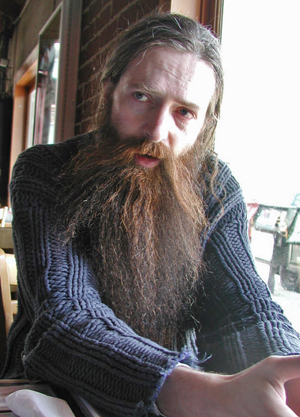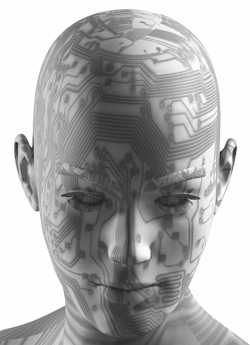
Your complimentary articles
You’ve read one of your four complimentary articles for this month.
You can read four articles free per month. To have complete access to the thousands of philosophy articles on this site, please
Tallis in Wonderland
Technoimmortalization
Raymond Tallis tells us how (not) to live forever.
For those of us who have no religious faith, death means death, even more surely than Brexit means disaster. We godless ones can no longer entertain the hope that, after we have left this world of transient things, we shall (if we have been good) awaken to an eternal life of unending bliss. The final tragedy, it appears to the atheist, is inescapable and universal.
Or it was until recently. Promise of salvation has come from an unexpected source – from the very science that has had such an important role in discrediting religion and disenchanting the world. Certain clever boffins think they may have found a route to eternal life. Most of the ideas of how this may be achieved are, well, bonkers, as are some of the prophets who preach salvation by technology. Nevertheless, their fantasies, as described in Mark O’Connell’s wonderful To Be A Machine (2018), are worthy of philosophical attention.
(Not) Dodging The Scythe
The most conventional approaches to life extension are endeavours to tinker with our biology to arrest ‘the ageing process’ – a term that does no justice to the complexity of what happens as the years add up.

Aubrey
Photo by Bruce Klein & Susan Fonseca-Klein
The best known (and best bearded) contemporary prophet of biological life extension is Aubrey de Grey, who has claimed that the first person to live to 1,000 years could be walking among us today. He argues that using present knowledge we could extend life sufficiently to gain time for new advances which will further extend life… By this means we shall achieve what he calls ‘biological escape velocity’, keeping just ahead of the Grim Reaper. But his claims are scarcely supported by biological science, as many gerontologists (full disclosure: including myself) have pointed out.
Equally implausible is the freezing of the body at or just prior to death so that it can be preserved until a cure has been found for the disease that killed (or will kill) the deceased. Unfortunately for those who have paid good money to be stored in readiness for resurrection, refrigeration would not bring salvation: even if their mortal parts were not lethally damaged by freezing, they would not survive thawing.
Marginally less implausible are cyborgs – short for ‘cybernetic organisms’ – individuals whose flesh is gradually replaced by hardware that is not susceptible to the ills to which the flesh is heir. The end-point would be a merger of people with machines that permitted an almost complete emancipation from organic existence. It seems however unlikely that the cyborg would have much in common with the fleshly organism it had replaced: personal identity would scarcely survive translation into impersonal machinery. Besides, while heart, kidney, and leg replacements may be possible, developing a prosthesis to stand in for the most important organ, the brain, presents insuperable challenges – of which more presently.
None of these strategies, anyway, would deliver immortality. Preventing, or even reversing, ageing would not protect the body from death by external events such as accidents or newly emerging diseases. Hybrids of body and machine would be susceptible to wear and tear, and their astronomical maintenance costs would depend on the good will of others, which is likely to be in short supply as the 900-year old presents yet again for even more advanced replacement therapy. The most pertinent point, however, is that a few hundred years added to one’s life are a mere eye-blink in eternity.
Something more radical is needed. We must escape completely from biology and the vulnerabilities of the flesh, or even of flesh-and-metal. This is where it gets philosophically interesting, and the topic of life extension earns its place in Philosophy Now – for here we encounter conceptual errors that are widespread contemporary thought, including that of many philosophers.
The (Non-)Uploaded Self
‘Technoimmortalization’ designates the dream of achieving immortal life by means of advanced information technology. The central idea is the uploading of the mind, or the identity, of the person on to an enduring non-biological substrate, for example into a computer. There are many versions of this proposal, but the most popular assumes that personhood is identical with the ‘information’ in the brain. (Inverted commas should often be employed when the word is used in this context, for reasons that will become apparent.) The trick, apparently, is to scan my brain and so extract the information contained within it which is putatively identical with my mind, my self, the person I am. This information is then copied on to a new, longer-lasting substrate. When the new substrate starts to decay, the information can be copied on to another substrate. And so ad infinitum.
There are many obvious problems. The first is that there would be nothing to stop the boffins producing hundreds of copies of me at any given moment. Secondly, a mind without its body would seem to lack an agenda. It would certainly be fundamentally different from the original embodied mind. Thirdly, this bodiless mind would also be worldless, because being-in-the-world is being in a shared world: the personal is interpersonal. In short, continuing personal existence on a non-biological substrate would be solitary and empty unless my world – whose scope is vast and ill-defined – were scanned and packaged along with me.
So, already many problems; but they are nothing compared with the contradictions in the very idea of ‘uploading’ me, which relies on identifying my personal identity with the ‘information’ stored in my brain. What I would wish to be preserved in any life extension would be my experiences, memories, thoughts, emotions, my imagination, my aesthetic sense, my empathy, my habit of laughing at my own jokes, and so on. In what sense are they all merely ‘information’? In order to be hoovered up through a computational scanner, they are presumably translated into a very large number of 0s and 1s. How they would these be translated back into experiences, thoughts, etc. is (to put it generously) not at all clear. As if this were not difficulty enough, individual items are profoundly interconnected. My memory of a past event links me with a past world which could hardly be reduced to and unpacked from the 0s and 1s supposedly corresponding to the discrete neural activity that is thought to be the memory’s original biological substrate. And an instantaneous snapshot taken by a brain scan would also not capture how I am extended in time. Tallis at time t is steeped in Tallis’s past and is pregnant with the future he anticipates and tries to control. Trying to capture that temporal depth by prolonging the snapshot would only result in a blur as different activation states of the brain are superimposed.
What’s more, it’s also not at all clear what has to be copied. For some writers, for instance, the information that should be captured by the scanner is not neural activity but the unique micro structure of my brain. Effectively, what must therefore be extracted would be a recipe for reconstructing a non-biological equivalent of my neural circuitry. This raises many problems, not least because there is no guarantee that even the same circuitry, reconstituted on, for example, silicon, would behave like the wetware of the brain. Moreover, living brain tissue is not reducible to merely its wires and connections. There can be no clear distinction between the information supposedly carried by or stored in the brain, the microscopic structure of the brain, and the juices that support that structure. They all have a hand in the ‘information’ that goes into making me me. The question then arises as to how much of that wetware – the brain’s living tissue – should be replicated.
(No) Thought For Information
The uploader’s troubles have only just started. There are two highly contestable ideas underpinning the concept itself: that the conscious subject is ‘information’; and that that information is of the kind that can be stored, transmitted or replicated.
The reduction of the self I wish to immortalize to information is a necessary step to making me replicable in the sort of way we’ve been considering. But the very fact that the information is replicable shows that it does not correspond to the unique, singular, irreplaceable, unreplicable me. Information is information because it is intelligible, and it is intelligible because it is general. So that which makes something information prevents it from reaching down to unique personal identity. Whatever the scan extracts will be impersonal.
Against this it might be objected that what is unique about me is not a particular bit of information, but a unique combination of items of information. But this won’t work: there is an unbridgeable gap between (first-person) experiences and impersonal information. My experience of sitting writing this piece in a taverna on the island of Samos cannot be replicated, even though the fact that I wrote this in a taverna on Samos can be replicated indefinitely. Experiences are ultimately incommunicable (and certainly not in any language composed of 0s and 1s), whereas communicable facts are ownerless, and belong to the community of minds.

The uploaded self: shaved of personality?
Circuit-board woman © istockphoto.com/tonispan
There is a more profound objection. Information transmission or sharing is a manifestation of human consciousness. So trying to build higher-level first-person consciousness out of bits of information is like trying to build the foundations of an unbuilt house out of its upper storeys. This would be self-evident were it not for the slipperiness of the term ‘information’ in philosophical discourse. Normally we understand that information involves at least one conscious being: the informed recipient of the information. The fact that information can be ‘stored’ for later interpretation misleads some into thinking that it can exist without consciousness, and hence could be the material out of which consciousness is constructed. But to separate information from consciousness in this way quickly leads to lunacy.
This is particularly relevant to our present concern, as many who argue for the possibility of information extraction as the basis of reconstructing consciousness see information everywhere. Consider this from David Chalmers: “wherever there is causal interaction, there is information, and wherever there is information there is experience. One can find information states in a rock – when it expands and contracts, for example – or even in the different aspects of an electron” (The Conscious Mind: In Search of a Fundamental Theory, 1996, p.297). It shouldn’t be necessary to point out that events count as information only when they inform someone – a conscious mind. Information is primarily something that passes between people. The rings in trees may inform us of their age, but the trees don’t know how old they are. Events become information only in the presence or states of a mind; so it is topsy-turvy to think of the mind as boiling down to information. If we forget that, then we soon arrive at a ‘pan-informational’ view of reality, in which the entire universe is talking about itself.
Mark Walker’s claim that “those who upload may be on their way to Godhood” (‘Personal Identity and Uploading’, Journal of Evolution and Technology, 2011) is therefore wishful thinking. What O’Connell in his book called “the confusion and desire and impotence and sickness of the body, cowering in the darkening shadow of its own decay” (p.164), looks likely to remain a permanent feature of the human condition.
I am sorry if this has spoiled your day, when you have so few of them.
© Prof. Raymond Tallis 2018
Raymond Tallis’ new book, Logos: The Mystery of How We Make Sense of the World has recently been published by Agenda.









